Some adventure parks are literally made in the shade, with ropes courses and other attractions built beneath a canopy of trees that provide natural cooling. Others, however, don’t have the benefit of being located in a mature forest, or have elements such as pools and waterslides where guests want to spend some—if not all—of their visit basking in sunlight.
That’s where creating artificial shade and other protected, cool spaces can be the difference between a fun day of play and a brutal, sunburned ordeal—one unlikely to be willingly repeated. “There’s a big shade revolution happening,” says Brydon Roe, CEO and co-founder of Shade Sails Canada, which has installed shade structures in playgrounds as well as locations such as Blue Mountain Resort in Ontario and Revelstoke Mountain Resort in British Columbia.
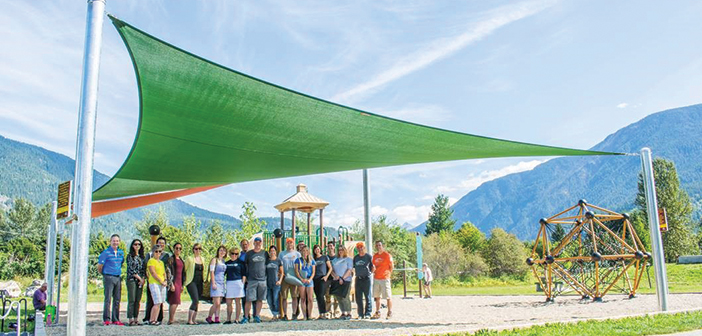
New shade structures from Shade Sails Canada at the entrance to Revelstoke’s mountain coaster.
This “shade revolution” is good for guests’ health, improves aesthetics, and can also be a boon for the bottom line.
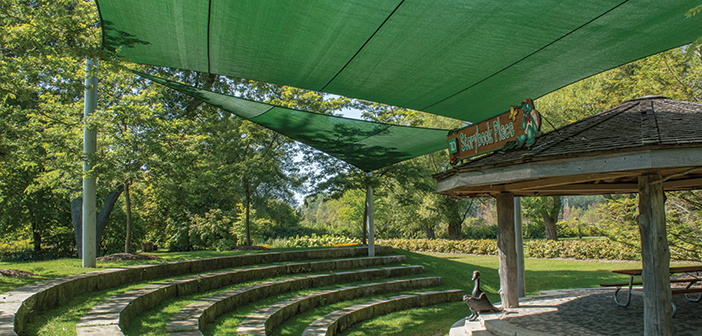
Blocking the sun for spectators at an ampitheater makes it a much more comfortable experience. (Shade
Sails Canada)
GOOD FOR HUMANS
We’ve all heard temperature expressed with the proviso “in the shade,” but in fact, shade does not decrease air temperature at all, researchers say. Rather, being in the shade and not the sun reduces the perception of temperature by 10º F to 15º F, because shade blocks solar radiation. In short, people feel cooler in the shade even if they really aren’t.
That’s not just true on hot summer days: Shade increases “thermal comfort significantly in the spring, summer, and fall,” according to researchers led by Ariane Middel, Ph.D., from Arizona State University, who added, “Thermal sensation responses did not significantly vary by shade type, suggesting that artificial and natural shade are equally efficient in mitigating heat stress.”
In addition to making guests feel cooler, some shade products provide up to 99 percent protection against the sun’s harmful UV rays. “When you’re working with kids, that’s very important to have,” says Maria Ramirez, marketing manager at Shade Systems, Inc., of Ocala, Fla.
So important, adds Roe, that providing adequate sun protection is mandatory in settings like school playgrounds and other kid-friendly public spaces, decreasing potential liability issues. “A lot of deaths are due to heat, so there’s a concern for health and a liability issue if there’s no shade,” says Roe. “And melanoma is one of the most prevalent forms of cancer people get. It’s a legitimate health risk.”
GOOD FOR BUSINESS
In addition to keeping people healthy, aerial adventure parks can keep their guests feeling good—and keep them in the park longer—by providing adequate shade in exposed areas such as ropes course platforms, water stations, and areas where people line up for tickets or to access attractions.
In Grapevine, Texas, for example, visitation rose 100 percent after multi-level sail shades from Shade Systems, Inc., were installed over a children’s play area and over seating areas at the city-owned Dove Waterpark in 2013.
“Attendance is up because our facility is now usable to more people for more hours of the day,” says Kevin Mitchell, director of the Grapevine Parks and Recreation Department. “Many play features would become unusable in the direct summer sun, and the play hours for children were extremely restricted during July and August.”
At Blue Mountain, Shade Sails Canada created shaded areas over the entryways to zip lines and outdoor dining areas, with great feedback from visitors. At Revelstoke’s new adventure center, the mounting and dismounting platform for the mountain coaster is also protected from the sun. So is the ticket line for the Banff Gondola in Alberta. “More comfort allows you to sell more tickets,” says Roe.

New shade structures from Shade Sails Canada at the entrance to Revelstoke’s mountain coaster.
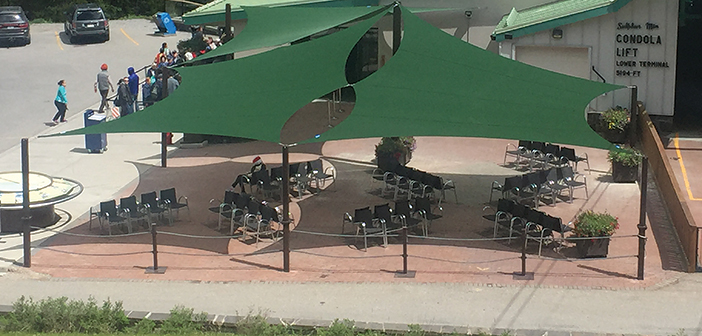
Shade is appreciated when the line is long at the Banff gondola.
GOOD FOR LOOKS
Compared to a tent, sail shades can be more aesthetically pleasing, coming in multiple color choices to match the setting—bright colors for a waterpark, muted ones for a wooded setting, for example—and varying heights and sizes. Metal or concrete posts make the shades permanent, durable structures that are “much cheaper than a roof,” according to Roe.
“You don’t want to be putting lime green sails on a mountain, but we can do a forest green with rust-colored poles,” he says. The height and angle of the sails and poles can also be modified to accentuate the surroundings.
Shade materials are waterproof, typically, although the sail variety, while durable, isn’t meant to hold the weight of snow and must come down in the winter. Other types of shade solutions can stay up year-round, however. Retractable shades also are available.
Shade Systems, Inc., offers canopy-like square, rectangle, hexagon, octagon, and cantilevered shades. “We make all kinds of shades for all kinds of weather,” says Ramirez. The company has brought shade to playgrounds, pools, waterparks, bleachers, restaurant and bar patios, and over walkways and benches. Shades can range in price from less than $4,000 to more than $100,000, depending on size, height, and the complexity of the install location (flat surfaces are cheaper).
The company mounts its shades on columns sunk into the ground; the shaades can be installed or removed by maintenance crews in less than a half-hour, in most cases, thanks to the company’s proprietary “turn and slide” fastening system, says Ramirez.
MIST-ICAL EFFECT
Something that actually does cool bodies down is water, which is why attractions often pair shade with misting systems that spread a fine spray in the air without soaking the skin. “As mist evaporates, it brings the temperature down,” says Bryan Roe, president of California-based Koolfog. “The purpose is to provide coverage to a space without wetting it.”
Misters are commonly used in cooling tents but can also keep guests comfortable while waiting on line for attractions. Systems consist of a high-pressure pump, plumbing, and misting pipes, fans, or poles—the latter not too dissimilar from the snowmaking towers used at ski areas.
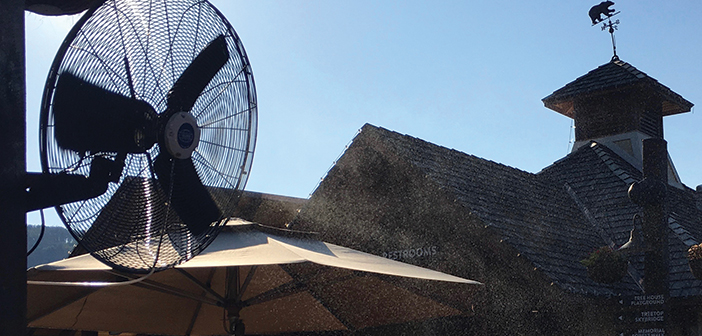
Misting fan at Anakeesta, Tenn.
In a cooling tent, the misting pipes are typically arranged around the edge to create a wall of moisture that guests move through as they enter or exit. That’s the setup at the adventure park at Killington, where misting systems from a company called Mr. Mister were added to a series of simple, 10’x10’ canopy tents to create heat relief for mountain bikers and
other guests.
Koolfog also makes heated- and chilled-water fog systems that can become part of attractions themselves. Imagine zip lining through a blanket of fog. “You can get more creative in attractions,” says Koolfog’s Roe. “Mist and fog give you the ability to create a unique effect and add some mystery to an attraction, to give it more of a ‘wow’ factor. Maybe it’s not strictly about cooling, but there’s a cool byproduct of it.”

Koolfog’s water fog system creates the misty fog in the background at the OKC Boathouse Rumble Drop
Misting and fogging systems can be tied to motion detectors or run continuously, such as in the fogged-out slide tubes at Universal Studios’ Volcano Bay waterpark, or on the Sandridge Sky Trail adventure course at Riversport in Oklahoma City, which includes the Rumble Drop free-fall into a mist-shrouded landing area.
Price points are based on numbers of misting nozzles, with prices ranging from about $300 to $5,000. Fewer nozzles are needed in less-humid regions, says Roe.
MULTI-USE SHADE
Umbrella bars like those sold by Umbrella Bars USA are shaded structures that have benefits far beyond providing an escape from the sun—such an installation can become the social epicenter of an outdoor space where guests can enjoy food and drink.
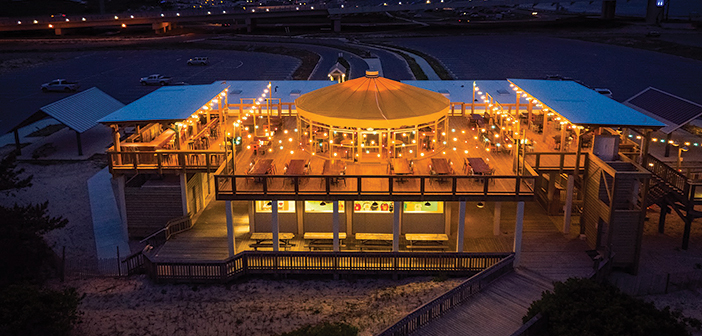
Umbrella Bars structures can provide both shade and unique F&B venues in a variety of settings.
As the name suggests, umbrella bars are structures covered by big, retractable umbrellas. Most are round or square, and cover anywhere from 172 sq. ft. to 2,147 sq. ft. The tops of the umbrellas open electronically, making weather-based adjustments easy, and side panels can also be opened or closed based on whether the operator wants to keep heat in or out that day. They come with fully equipped bars, too.
Prices for umbrella bars start at around $200,000 for a 7-meter (23 foot) diameter model, according to Umbrella Bars USA president Tom McHugh. Larger models can run upwards of $500,000 and seat up to 120 people.
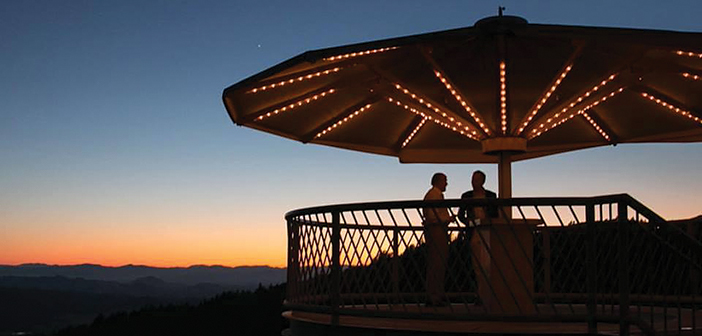
A twinkle-lit Umbrella Bars shade structure can add ambience at night as well as a shady resting spot during the day.
BE COOL
Aside from umbrella bars that generate food and beverage revenue, calculating the ROI for shade structures can be challenging. It’s apparent that in certain situations, though, they drive more business—remember the example of Dove Waterpark.
One thing is for sure—giving your guests more options to enjoy the shade is a very cool thing to do.






